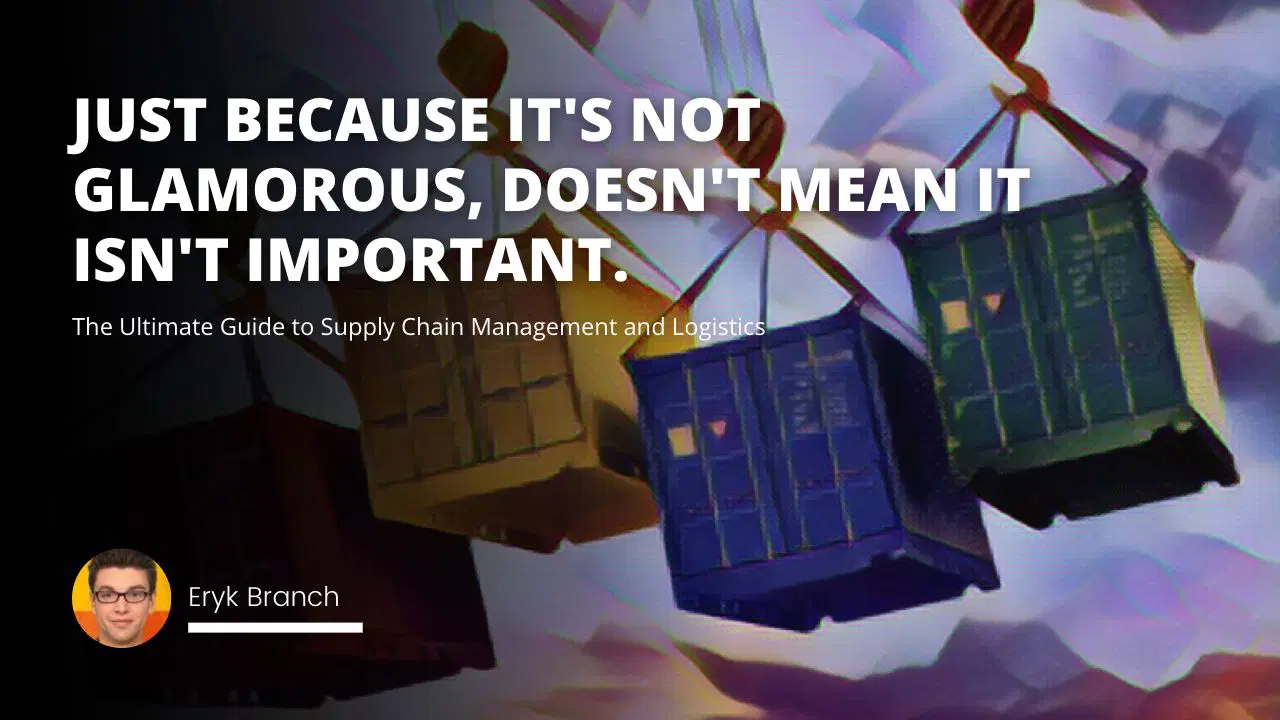
If you're looking for a comprehensive guide to the ins and outs of supply chain management (SCM) and logistics, you've come to the right place. This post will look at what SCM is, why it's essential, and some of the key concepts and terminology you need to know. We'll also explore SCM's different aspects, such as purchasing, order fulfillment, and shipping. By understanding these concepts, you'll be able to develop an effective SCM strategy that will help your business run more smoothly and efficiently.
What are supply chain management and logistics, and what are their key components?
Supply chain management (SCM) manages the flow of goods and services from suppliers to customers. Logistics is a critical component of SCM and refers to transporting and storing goods. Together, these two concepts cover various activities, from sourcing raw materials to delivering finished products to customers.
To effectively manage their supply chains, businesses need to have visibility into all process aspects. This includes understanding where goods are at every stage of the journey and being able to track and predict changes in demand. By having this visibility, businesses can make informed decisions about best allocating their resources.
Many different software solutions are available that can help businesses with their SCM. These solutions can automate and streamline many of the tasks involved in managing a supply chain, from sourcing to shipping. In addition, they can provide businesses with the visibility they need to make informed decisions about their supply chain.

Why is supply chain management critical?
Supply chain management is essential because it allows businesses to optimize their operations and maximize efficiency. By having visibility into all aspects of the supply chain, companies can make better decisions about allocating their resources. Additionally, by automating and streamlining tasks related to SCM, businesses can save time and money.
SCM is also important because it helps businesses manage risk. By understanding where goods are at every journey stage, companies can anticipate and address potential problems. Additionally, by having visibility into the supplier network, companies can identify and manage risks associated with suppliers.
Maximizing Inventory Costs: Tips for Supply Chain Management
Connecting Supply Chain Communities: How Culture Impacts Supply Chain Management
Supply chain management is essential because it allows businesses to optimize their operations and maximize efficiency.
By having visibility into all aspects of the supply chain, companies can make better decisions about allocating their resources.
Additionally, by automating and streamlining tasks related to SCM, businesses can save time and money.
SCM is also important because it helps companies to manage risk. By understanding where goods are at every journey stage, companies can anticipate and address potential problems.
What challenges does supply chain management present for businesses, and how can they be overcome?
There are several challenges that businesses face when it comes to SCM. One of the biggest challenges is maintaining visibility into the supply chain. This can be difficult because the supply chain is often complex, with many players involved. In addition, the flow of goods and services can change rapidly, making it difficult to keep track of all the moving parts.
Another challenge that businesses face is managing risk. As mentioned above, companies can anticipate and address potential problems by understanding where goods are at every stage of the journey. However, this requires businesses to have access to accurate and up-to-date data. Additionally, companies need to be able to quickly adapt their plans in response to changes in the supply chain.
Finally, businesses need to be able to manage their inventory effectively. This includes tracking inventory levels, predicting future demand, and making adjustments to production plans. Effective inventory management can help businesses avoid stockouts and shortages, disrupting the supply chain and leading to lost sales.
Maintain visibility into the supply chain
Reduce risk in the supply chain
Improve communication within the supply chain
Automate processes to improve efficiency

How do different types of businesses approach supply chain management differently, and what are the benefits?
Different types of businesses have different SCM needs. For example, a manufacturing company will have additional SCM requirements than a retail company. Therefore, companies need to tailor their SCM approach to meet their specific needs.
One of the benefits of tailoring the SCM approach is that it can help businesses save time and money. Companies can avoid wasting time and resources by optimizing the SCM process for their specific needs. Additionally, by having a well-designed SCM system, businesses can improve their efficiency and reduce costs.
Another benefit of tailoring the SCM approach is that it can help businesses improve customer satisfaction. By understanding the needs of their customers, companies can develop a supply chain that can meet those needs. This can lead to happier customers and repeat business.
Tailor your SCM approach to meet your specific needs.
Achieve improved efficiency and logistical performance.
Minimize stockouts and excess inventory.
Manage supplier and customer relationships more effectively.
What are some best practices for optimizing a company's supply chain and logistics operations?
Businesses can use several best practices to optimize their SCM operations. One best approach is to develop a clear understanding of the needs of the business. This includes understanding the company's goals and the needs of the customers. Once this understanding is in place, companies can develop an SCM plan tailored to meet those needs.
Another best practice for optimizing SCM is to establish clear lines of communication. This means having a system in place for sharing information between all supply chain members. By doing this, businesses can avoid misunderstandings and mistakes. Additionally, it can help companies make better decisions by having all the relevant information available.
Another best practice is to use technology to automate and streamline the SCM process. By using SCM software, businesses can reduce the time and resources needed to manage the supply chain. Additionally, SCM software can help companies improve visibility into the supply chain and make it easier to track and manage inventory.
Finally, businesses should regularly review their SCM process. By doing this, they can identify areas where improvements can be made. Additionally, reviewing the SCM process can help businesses keep up with changes in the marketplace and adapt their approach as needed.
Supply chain management and logistics are essential for businesses of all sizes, and these functions have evolved over the years to meet the ever-changing needs of companies. While some challenges must be overcome to optimize a business' supply chain and logistics operations, these can be addressed with careful planning and execution. In addition, by taking a holistic approach to supply chain management and considering the unique needs of their business, companies can enjoy significant benefits in terms of efficiency, cost savings, and customer satisfaction. Want to learn more? Check out our upcoming Supply Chain Management course.
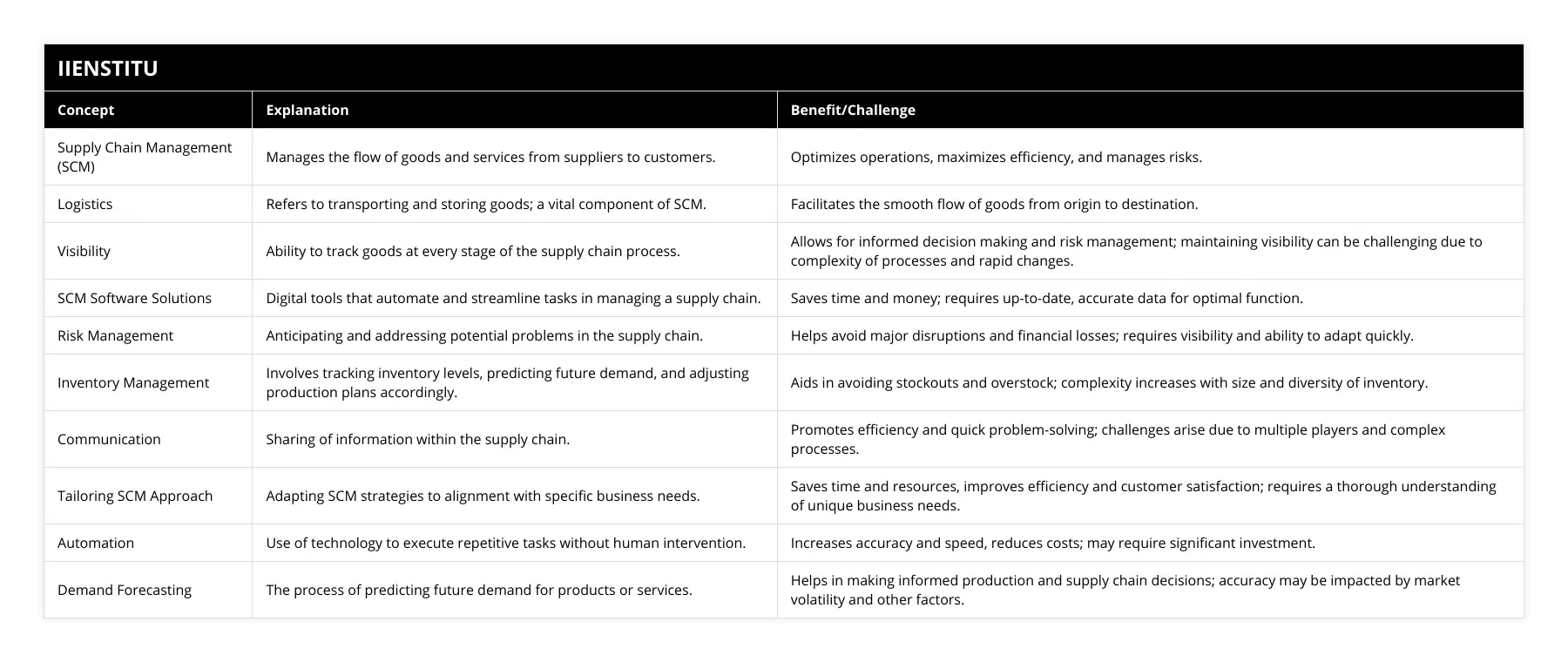
Frequently Asked Questions
What is the ultimate goal of supply chain management and logistics?
The ultimate goal of supply chain management and logistics is to move goods from suppliers to customers in the most efficient and cost-effective way possible. This includes ensuring that the right goods are delivered to the right places at the right times, while minimizing waste and maximizing profits.
What are the key components of supply chain management and logistics?
The goal of supply chain management and logistics is to ensure that materials and products are delivered to the desired destination in an efficient and cost-effective manner.
This includes forecasting future demand, organizing the flow of goods through the supply chain, tracking inventory levels, and ensuring that shipments arrive on time and in good condition. By streamlining the process from supplier to customer, businesses can save time and money while delivering a superior customer experience.
How has supply chain management and logistics evolved over the years?
The field of supply chain management and logistics has evolved over the years to become a more strategic and analytical field. Today, there is a greater focus on improving the flow of goods and materials through the supply chain in order to improve operational efficiency, reduce waste, and maximize profits.
In addition, advances in information technology have allowed for the development of sophisticated software tools that can help managers optimize their supply chains down to the level of individual shipments. This allows businesses to be more responsive to changes in the marketplace and better able to compete in today's global economy.
What are the 7 R's of logistics?
Understanding the 7 R's of Logistics
Essential Principles of Logistics Management
The 7 R's of logistics refer to a framework that focuses on the key aspects of logistics management. The goal of implementing the 7 R's is to ensure an effective and efficient supply chain that not only meets customer expectations but also minimizes costs for companies. Understanding these R's will enable organizations to improve their logistics operations and streamline the overall process.
Right Product
Ensuring the right product is shipped to the end customer is essential in logistics management. This entails accurate tracking of inventory, proper packaging, and thorough quality control. Proper product handling and storage will prevent damage or spoilage of goods and ensure customer satisfaction.
Right Quantity
The right amount of products should be shipped to meet customer demand. Balancing the inventory levels between overstocking and stockouts is crucial for optimizing costs and maintaining high levels of customer service. Proper forecasting and inventory management techniques can help companies achieve this goal.
Right Condition
Maintaining the right condition of products during transportation and storage is vital to satisfy customer expectations. This includes appropriate temperature control, humidity levels, and protective packaging to ensure the product arrives in perfect condition. Proper handling of perishable or fragile items is especially important.
Right Place
Delivering products to the correct location is a core aspect of logistics management. Efficient routing, accurate addressing, and reliable transportation networks are essential for ensuring a smooth and timely delivery. It is also necessary to select the most appropriate distribution center or warehouse for optimal product flow.
Right Time
Timely delivery is critical in today's competitive business environment. Meeting promised delivery dates and providing accurate tracking information is vital for maintaining high levels of customer satisfaction. Effective scheduling and collaboration with carriers can help companies achieve on-time deliveries.
Right Cost
Optimizing the cost of logistics operations to maintain profitability is crucial for companies. This includes selecting cost-effective transportation modes, minimizing warehousing expenses, and streamlining labor costs. Proper analysis of logistics data can help identify areas for improvement and achieve cost savings.
Right Customer
Finally, delivering the products to the correct end customer is essential. Accurate customer data management and order processing are vital to ensure correct deliveries, minimize returns, and maintain customer loyalty. Investing in customer relationship management (CRM) systems can help companies achieve this goal.
In conclusion, the 7 R's of logistics provide a comprehensive framework for managing, analyzing, and optimizing logistics and supply chain operations. By focusing on these key aspects, companies can improve the efficiency of their logistics processes, enhance customer satisfaction, and achieve cost savings. Implementing the 7 R's can help businesses succeed in today's competitive market.
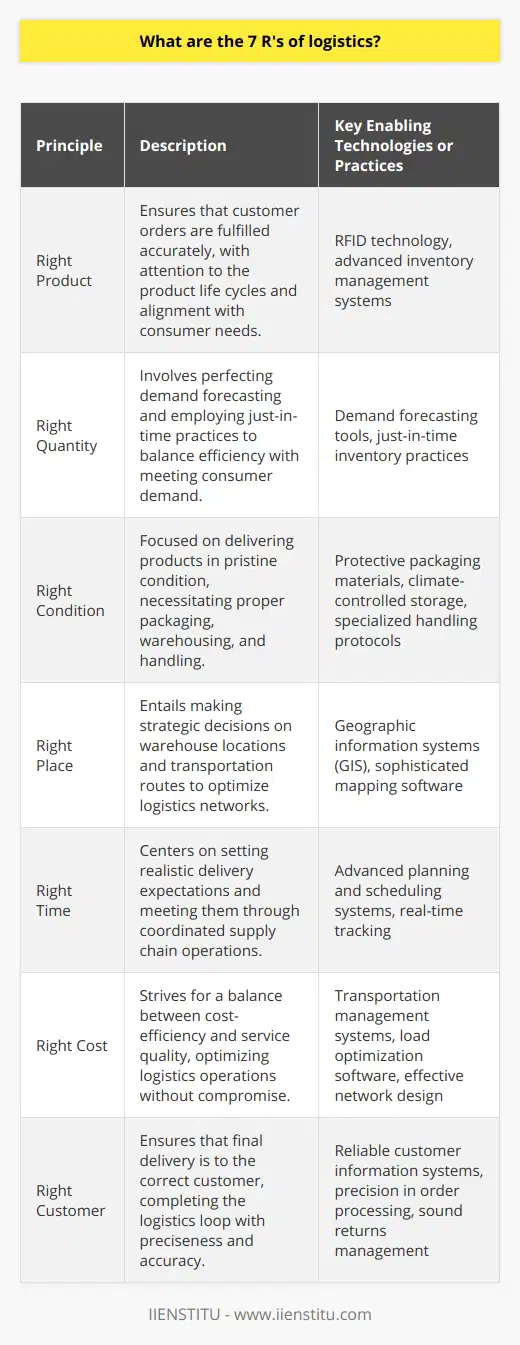
What is ultimate supply chain management?
Defining Ultimate Supply Chain Management
Ultimate supply chain management can be described as a comprehensive approach that integrates all aspects of the end-to-end process, involving the movement of goods and services from suppliers to end consumers. It not only necessitates efficient and effective coordination and communication among various stakeholders but also emphasizes continuous innovation and adaptability to address the dynamic needs of the market.
Key Components of Ultimate Supply Chain Management
Strategic Sourcing and Procurement
This component involves identifying, evaluating, and selecting the most suitable suppliers to meet the organization's requirements. It encompasses the establishment of long-term relationships, contract negotiation, and the implementation of supplier performance and risk management systems.
Production and Manufacturing
Efficient production and manufacturing systems are essential for effective supply chain management. This includes the utilization of lean principles, continual process improvement, and technology integration to enhance productivity, reduce waste, and facilitate flexibility in meeting customers' demands.
Distribution and Logistics
Ultimate supply chain management requires an efficient distribution and logistics network. This includes transportation management, warehousing, and inventory control practices that optimize the movement of goods while minimizing associated costs and environmental impacts.
Sales and Operations Planning
A crucial aspect of ultimate supply chain management is the ability to align demand and supply effectively. This is achieved through sales and operations planning processes that incorporate forecasting, demand management, and production planning, ensuring a responsive and flexible supply chain.
Integration of Information Systems
Advanced information systems are vital for ultimate supply chain management, as they facilitate real-time data sharing and communication among stakeholders. This technology integration enables enhanced visibility, streamlined decision-making, and improved overall efficiency within the supply chain.
Sustainability and Risk Management
A sustainable and resilient supply chain is essential for long-term competitiveness. Ultimate supply chain management involves the implementation of environmental, social, and governance (ESG) practices, along with robust risk management systems to mitigate potential disruptions and minimize adverse impacts.
Conclusion
In summary, ultimate supply chain management encompasses a holistic approach that addresses various aspects of the entire process from procurement to distribution. This requires strategic planning, advanced technology integration, and continuous improvement initiatives, creating a responsive, adaptable, and sustainable supply chain that provides a competitive edge in today's global marketplace.

What are the basics of supply chain and logistics management?
Supply Chain Fundamentals
In essence, supply chain and logistics management involves the organization, coordination, and monitoring of various activities necessary to move products and resources from the point of origin to the final destination. An efficiently managed supply chain ensures that materials, information, and financial resources follow through to maximize value to the customers and maintain competitiveness in the market.
Elements of Supply Chain Management
Key components of supply chain management include procurement, production, transportation, warehousing, and distribution. Procurement entails sourcing raw materials and negotiating contracts from suppliers. Production involves converting raw materials into finished goods suitable for consumption. Transportation includes the movement of raw materials, work-in-progress and finished goods through various stages of production, while warehousing focuses on the storage of goods until their dispatch. Lastly, distribution entails delivering products to customers through the appropriate channels.
Logistics Management
Logistics management is a subset of supply chain management dealing mainly with the transportation and storage of products. This function ensures that the right products are available at the right place and at the right time. The primary goal of logistics management is to optimize the movement of products through the supply chain, minimizing costs, and maximizing customer satisfaction.
Supply Chain Visibility
Visibility in the supply chain is the ability of all its stakeholders to track and trace the movement of goods and information. Companies should strive to maintain a transparent supply chain in order to improve efficiency, ultimately reducing inventory costs, enhancing customer service levels, and promoting better decision-making.
Technology in Supply Chain Management
Supply chain and logistics management are increasingly reliant on technology. Software solutions, such as enterprise resource planning systems and transportation management systems, are crucial tools that aid companies in managing their supply chains more effectively. Additionally, emerging technologies, like the Internet of Things, blockchain, and robotics, are expected to reshape the supply chain landscape, enhancing productivity, and driving innovation.
In conclusion, the basics of supply chain and logistics management involve the integration of all necessary activities moving goods from suppliers to customers, including procurement, production, transportation, warehousing, and distribution. Effective logistics management ensures the optimization of these processes by focusing on the proper movement and storage of products. As technology continues to evolve, supply chain and logistics management will increasingly rely on innovation to streamline and enhance these operations.

What are the 4 fundamentals of supply chain management?
Fundamentals of Supply Chain Management
Understanding Inventory Management
A crucial aspect of supply chain management is inventory management, which involves maintaining appropriate stock levels to meet customer demand without excess. Proper inventory management reduces carrying costs, mitigates risks of stockouts or obsolescence, and ultimately, improves overall supply chain efficiency.
Implementing Demand Forecasting
Another fundamental aspect of supply chain management is demand forecasting, which refers to predicting future customer orders based on historical data and market trends. Accurate demand forecasting enables businesses to plan production, allocate resources, and adjust inventory levels optimally. This in turn leads to better customer service, reduced operational costs, and increased revenue.
Effective Cost Management
Efficient cost management is essential to supply chain management, as reducing costs and enhancing profitability are central goals for any business. By streamlining operations, optimizing transportation and warehousing expenses, and implementing cost-saving technologies, businesses can achieve better control over their supply chain costs. This will result in a competitive advantage and a healthier bottom line.
Developing Strategic Supplier Relationships
Lastly, cultivating strong relationships with suppliers is a fundamental aspect of supply chain management. Strategic supplier relationships provide businesses with benefits such as access to better prices or higher quality products, leading to an increased level of trust and collaboration. This facilitates improved communication and problem-solving capabilities, which ultimately has a positive effect on the overall supply chain performance.

How do the 7 R's of logistics impact supply chain efficiency and effectiveness?
Relationship Between 7 R's and Supply Chain Efficiency
The foundation of logistics comprises the 7 R's: the Right product, Right price, Right place, Right quantity, Right quality, Right customer, and Right time. These principles directly impact the efficiency and effectiveness of supply chain operations, leading to improved customer satisfaction and increased profitability.
Right Product and Price
The Right product at the Right price ensures that supply chain managers select and procure items that accurately meet customer demands and expectations. By managing this aspect properly, companies can maximize sales while minimizing excess inventory.
Right Place and Quantity
Effective transportation and distribution strategies enable the Right place and Right quantity of products. This allows for just-in-time delivery, reducing storage costs and ensuring that products reach customers before obsolescence occurs.
Right Quality
Maintaining the Right quality of goods in the supply chain is crucial for upholding brand reputation and reducing returns. Quality management techniques, such as Total Quality Management (TQM), help monitor product standards and minimize defects in production.
Right Customer
Identifying and targeting the Right customer groups are critical for sales and demand forecasting. Proper demand planning reduces the risk of stockouts or overstocks, optimizing the supply chain's overall efficiency.
Right Time
The Right time of product delivery is crucial for maintaining customer satisfaction and generating repeat business. Employing efficient transportation and warehouse management systems ensures timely delivery and minimizes order cycle times.
In conclusion, the 7 R's of logistics are intertwined with the efficiency and effectiveness of the supply chain. By adhering to these principles, organizations can optimize their operations, minimize costs, and enhance overall customer satisfaction, ultimately leading to better business performance.
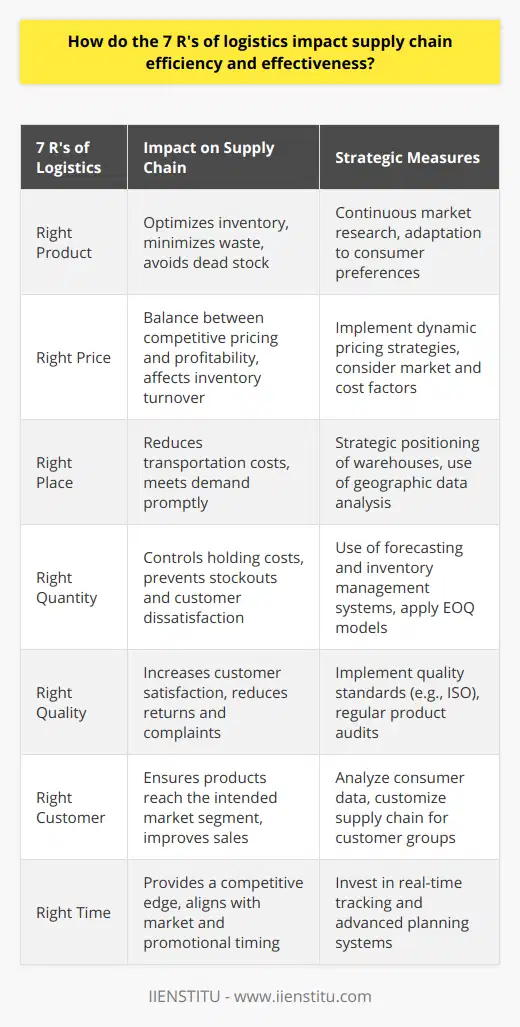
How do organizations apply the basic principles of supply chain and logistics management for strategic planning and decision-making?
Understanding Supply Chain and Logistics Management
Organizations employ a range of supply chain and logistics management principles to develop strategic plans and make well-informed decisions. These principles encompass various aspects such as demand forecasting, inventory management, transportation and distribution, and coordination among different firms in the supply chain.
Demand Forecasting and Inventory Management
Effective demand forecasting drives efficient inventory management, which in turn ensures availability of goods while minimizing stock maintenance costs. Organizations assess historical data, industry trends, and external factors to predict future demand accurately. This enables streamlining production, distribution, and sales to achieve better customer satisfaction while minimizing wastage.
Coordination and Collaboration among Partners
Smooth functioning of the supply chain relies on coordination and collaboration among partners, including suppliers, manufacturers, distributors, and retailers. Collaborative practices such as information sharing, joint planning, and synchronized decision-making enable all parties to work towards common goals. Such practices facilitate seamless flow of products, information, and funds while enhancing overall supply chain efficiency.
Transportation and Distribution Strategies
Choosing suitable transportation and distribution strategies is crucial for organizations to ensure timely and cost-efficient delivery of goods to end customers. Factors such as shipment size, distance, transportation mode, and service requirements dictate the appropriate strategies. Proper management of logistics resources plays a pivotal role in maintaining a competitive edge and meeting customer expectations.
Continuous Improvement and Sustainability
Underpinning successful supply chain and logistics management is a commitment to continuous improvement and sustainability. Organizations must regularly review and adapt their strategies to address dynamic market conditions, technological advancements, and evolving customer expectations. Additionally, adopting eco-friendly practices and focusing on reducing waste and carbon emissions help in building a sustainable and responsible supply chain, which can cater to today's environmentally conscious consumers.
In conclusion, a systematic and strategic approach to supply chain and logistics management is essential for organizations to optimize their operations and ensure long-term success. By integrating these basic principles into their strategic planning and decision-making processes, organizations can effectively address the challenges presented by global markets and deliver improved services to their customers.
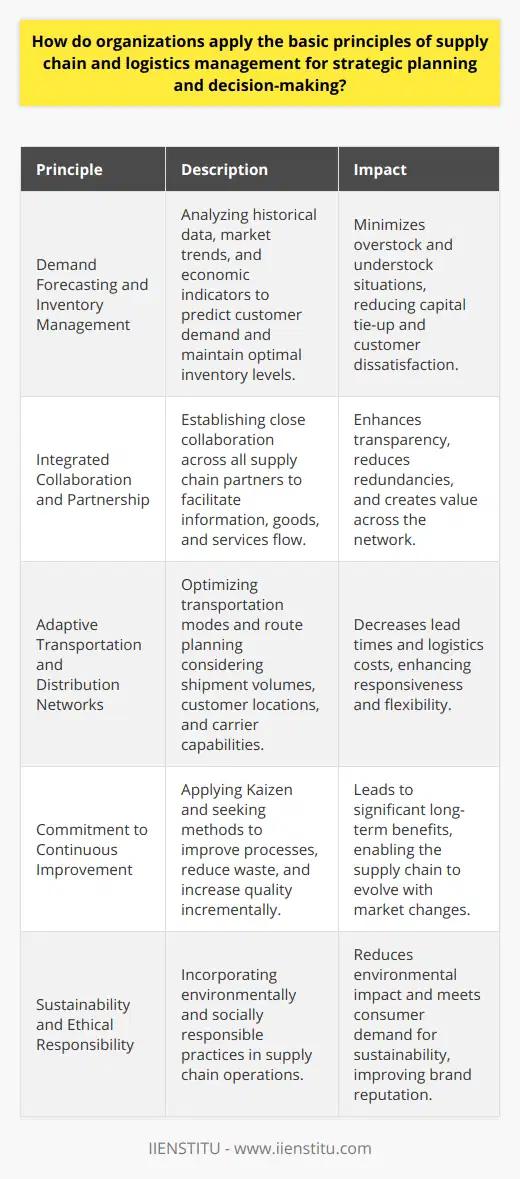
What are the 5 basic steps of supply chain management?
Understanding the Supply Chain Management Process
The process of supply chain management unfolds across five basic steps. These sequential steps play a significant role in governing the flow of goods and services across various entities within a supply chain.
Planning Phase
The first step involves strategic planning. Companies evaluate their resources and needs to construct an effective supply chain strategy. This strategy outlines their procedures for meeting customer demand and achieving competitive advantage.
Sourcing Providers
The second step pertains to selecting suppliers. Businesses need to carefully identify, vet, and contract suppliers who can reliably provide the necessary goods or services. Contract management and order placement also occur in this step.
Manufacturing and Production
The third step is manufacturing and production. As central operations, they involve scheduling, production, testing, packaging and preparing for delivery. Ensuring efficiency in this phase significantly impacts a company's overall profitability.
Delivery and Logistics
Next, in the delivery and logistics step, companies organise the transportation of finished goods to businesses or final customers. This phase demands effective use of logistics to facilitate on-time and safe deliveries.
Returns Processing
The final step involves handling returns or after-sales service. Inevitably, not all products will perfectly reach or suit customers. Addressing these situations with efficient return policies and processes maintains customer satisfaction and loyalty.
In conclusion, these five key steps constitute the core mechanisms underpinning supply chain management. By mastering each stage, businesses can enhance their efficiency, reduce costs, boost customer satisfaction, and gain a competitive edge.
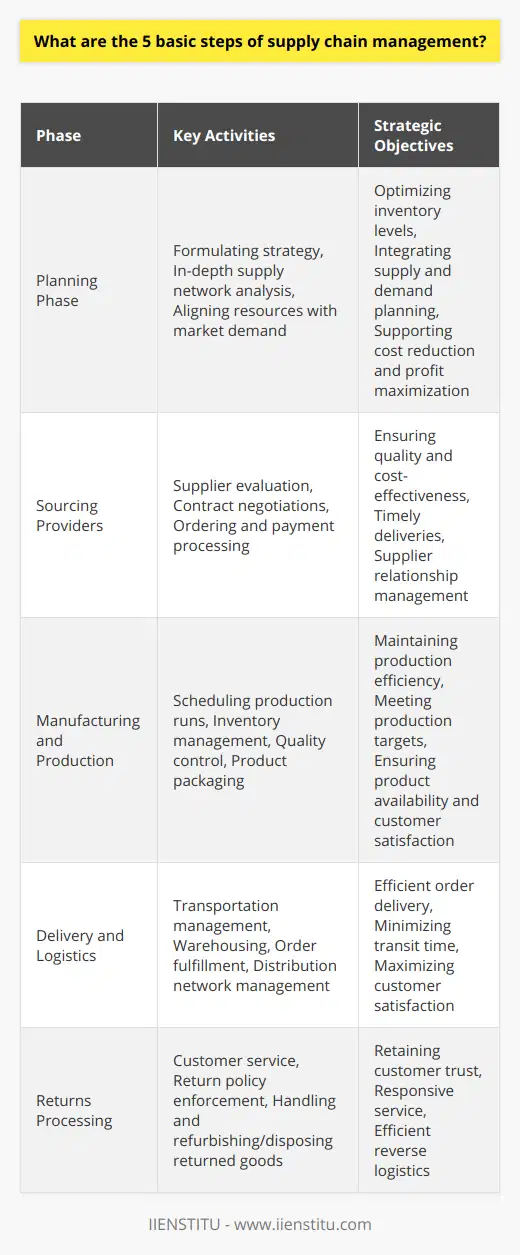
What are the 7 prerequisites for a more successful supply chain management?
Effective Communication
The foremost prerequisite for successful supply chain management involves effective communication. This ensures all stakeholders understand their roles and responsibilities. Timely and clear communication prevents misunderstandings and delays.
Integrated Technology Systems
Secondly, integrating technology systems is crucial. Digitalization facilitates real-time monitoring, data sharing, and more accurate forecasting. This greatly enhances efficiency and decision-making processes.
Effective Inventory Management
Thirdly, effective inventory management is essential. Businesses should accurately forecast demand to avoid overstocking or understocking. This manages costs and upholds customer satisfaction.
Supplier Relationship Management
Fourthly, nurturing good relations with suppliers helps in achieving a more successful supply chain. Strong supplier relationships contribute to negotiation of better terms and prompt problem-solving.
Risk Management Capabilities
Fifthly, possessing risk management capabilities can tackle unforeseen issues. This includes identifying potential risks and creating contingency plans. It safeguards the supply chain from disruptions and ensures business continuity.
Efficient Logistics
Sixthly, efficient logistics cannot be overlooked. The ability to move goods swiftly and cost-effectively across different points is critical. This includes procuring, storing, and delivering goods at the right time and place.
Quality Assurance
Finally, quality assurance plays a pivotal role. Stakeholders must ensure that all the products and processes satisfy the defined quality standards. This gains customer trust and supports long-term business sustainability.
In essence, these seven prerequisites can substantially improve supply chain management potential. Incorporating them into strategies can lead to cost reductions, increased efficiency, and a more resilient supply chain.
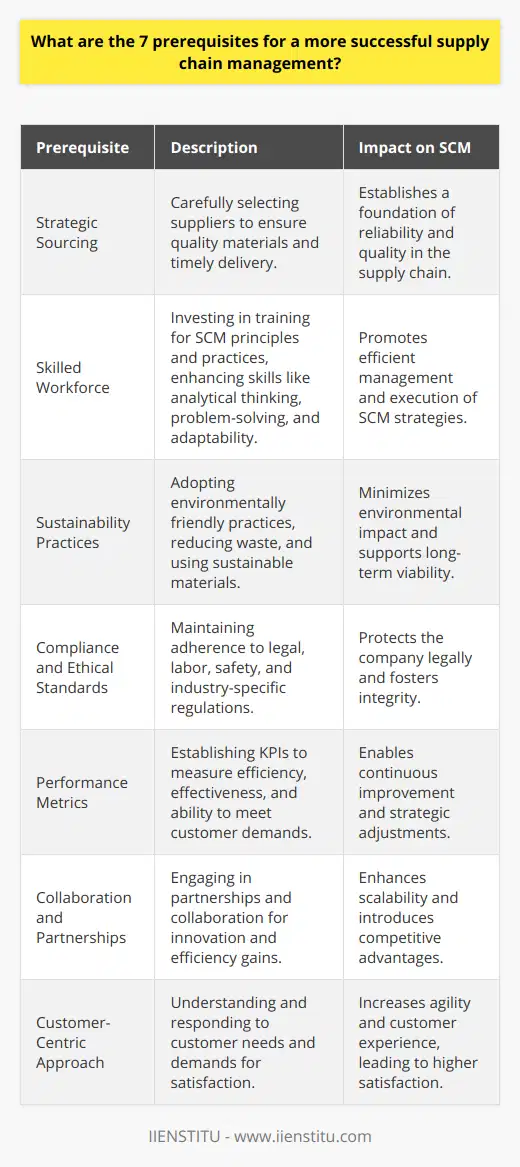
How do current trends and technology advancements impact supply chain and logistics management?
Current Trends and Technological Impact
In the ever-evolving world of supply chain and logistics, technology and trends influence the industry significantly. Current trends such as automation, artificial intelligence and digitization have fundamentally altered the way supply chain operations work.
Effects of Automation
Automation technology offers significant benefits including efficiency and accuracy. Automated tools manage operations with minimal human intervention, reducing errors. This enables prompt action, less waste and better productivity.
Artificial Intelligence Influence
Artificial Intelligence (AI) has revolutionized supply chain operations. AI aids in predictive analysis and decision making, enhancing operational efficiency. It also facilitates faster delivery times and inventory management accuracy.
Impacts of Digitization
Digitization has had a profound impact on logistics. It offers real-time tracking, improves coordination among teams, and enhances customer service. Digital technology improves the visibility and flexibility of the supply chain, boosting overall performance.
A Culture Shift in Logistics Management
Technology has also influenced a culture shift in logistics management. Companies now prioritize data-driven approaches to minimize risks and improve decision-making. Adopting these newer technologies and trends has become essential for survival and competitiveness in the logistics industry.
In conclusion, the ongoing technological advancements and trends have a substantial impact on supply chain management. They offer increased productivity, efficiency, and flexibility. The supply chain and logistics sectors must adapt to these changes to stay ahead in this competitive world.



